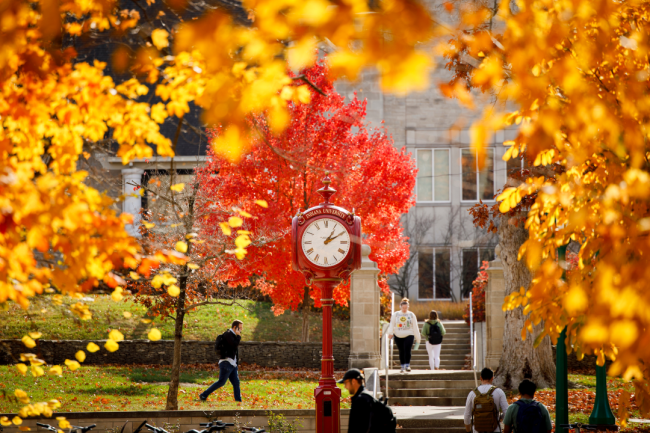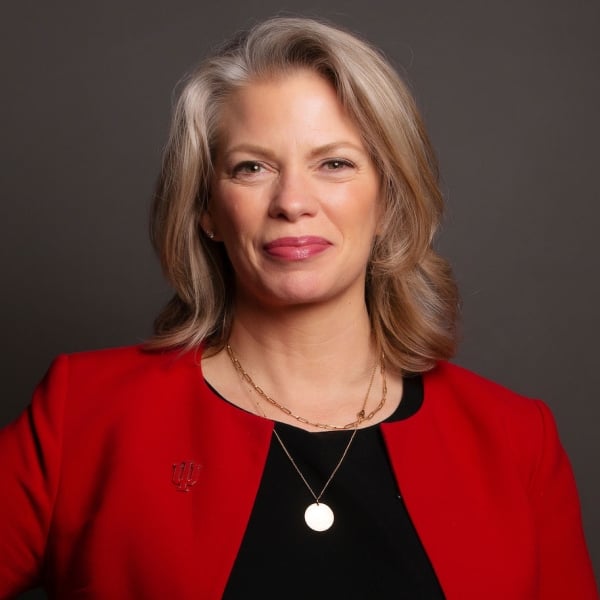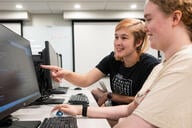You have /5 articles left.
Sign up for a free account or log in.

As vice president for student success at Indiana University, Julie Payne-Kirchmeier is responsible for student achievement across the university’s five campuses and two regional centers.
Indiana University

Julie Payne-Kirchmeier, vice president for student success at Indiana University
Indiana University
Julie Payne-Kirchmeier was an undergraduate student at Texas A&M in the genetics program when she realized she didn’t want a career in the sciences.
“I was working in a lab, and I was growing mold all day, and I had one of those, we will call them growth moments for a student. I think, individually, I called it a freakout moment,” Payne-Kirchmeier says.
After turning to her student organization adviser for guidance, Payne-Kirchmeier realized the out-of-classroom leadership experience she’d gotten was her favorite part of her college career, and the adviser opened her eyes to working in student affairs.
Payne-Kirchmeier is the inaugural vice president for student success at Indiana University, serving as head of retention and success efforts across the university’s campuses and regional centers.
“Throughout the course of my career, I’ve always come back to that central point, which is, there are so many people at a university—regardless of institution size and type—that really are invested in helping our students to not just succeed but to find out who they are and align that purpose with what they want to do for the rest of their life,” Payne-Kirchmeier says. “And I want to be one of those people.”
Payne-Kirchmeier started her role in June 2022. In the year since, she has spent time understanding the needs of students, the research behind student success work and the on-the-ground expertise of IU staff. She spoke with Inside Higher Ed about her vision for the position and her future goals.
Q: What’s the institutional mission around your new role?
A: This role is relatively unique. Some campuses have a system; others are a large university with multiple campuses—that’s what IU is. And particularly [a role] that is sitting at a vice president’s level and on the president’s cabinet, and really looking at student success across, in our case, seven institutions, two regional centers and, for undergrads, grads and professional students, so it’s vast.
It’s wonderful when a president like Pam Whitten steps forward and says, “We need somebody to do this” … One of the main reasons I came is because of her leadership, and that was exciting to me. It also, I think, underscores a really important point, when you’re trying to enact robust system-level change, your leader has to own it and keep it at the core. And she said, from day one, “Students are the center of the universe of everything that we do at Indiana University.”
The first pillar at the university level, and on every single campus, [in the 2030 strategic plan] will be student success and opportunity. We’ve taken it and embedded it into the fabric of the institution in a way that is focused, clear and the expectations are there and there are metrics out there in the public, so it’s transparent. It was developed by hundreds of people on our campuses, and that’s helped us focus those efforts … It truly is who we are and what we do.
Q: You’re new to the institution. What was it like for you to lay the groundwork for this inaugural role? How did you get to know all these different campuses and regional centers?
A: I really enjoy the creation process of anything. There are moments in your career where, as you’re living it, you don’t see the quilt pattern emerge until you turn around and say, “Oh, what was happening was I was moving through my career.”
Everything, from the early Student Affairs work I would do in housing and residence life, to working at the University of Southern Indiana and helping leadership there establish living-learning communities, developing strategic plans for new approaches for things, moving to Southern Illinois University and then stepping into that role that really bridged student affairs and academic affairs with academic support when we created a university college. And then moving to Northwestern and really diving into how the student experience truly changes things, particularly for folks and students who are coming from historically marginalized backgrounds and excluded backgrounds. All of those experiences, I think, prepared me well to be at a place that has such a vibrant and diverse university portfolio.
We’ve got flagship, we have a metropolitan campus, we have five regional campuses, one of them is a Hispanic-serving institution, another is an emerging Hispanic-serving institution. We have an award-winning online education program. Now, I look back and go, “Oh, OK, there was some preparation happening there.” So I think I was pretty well positioned to step in.
But how [did] we approach the work? It started, as many transitions do, with a lot of listening and seeking to understand. There were many meetings with groups, lots of different stakeholders—students, faculty, staff, alumni. I and my very small team at the time went and did campus visits, particularly for our regional campuses. To best understand it, we reviewed reams of data. We educated ourselves in the research in the literature around student success work.
We educated ourselves on what the current state was and built up our purpose, built up our guiding principles, and then went back and said, “This is what we think,” checked that with the full team, and then went forward and created a framework based on all of that, starting with our undergrads, on what success looks like.
You’ve got to have that level of buy-in, and a deep understanding from the people who are doing the work in our campus space partners, before you can turn around and say, “OK, this is the direction that we’re going to collectively go.” It also helps to inform the work around creating IU 2030, and that student success and opportunity pillar. And again, I credit our president’s cabinet and the president with making sure we have the space and time to do that, so we were advising people the right way when we were developing that plan.
Q: What is your personal philosophy when it comes to student success?
A: The first thing I’m gonna say is thank you for saying “philosophy” and not “definition” … this is layered, and it starts with understanding the person in front of you, the student as a whole human being.
We hear the term “holistic student support” thrown around a lot, but it really is a meaningful phrase. Because you’re looking at that person, they have hopes and dreams and desires, you get to know who they are and what their needs are, and we work—not just to meet them—but help … understand them so they can then have engagement or opportunity in this entire process.
At the end of the day—and we can talk about the research in the literature behind this if you want—I want our campus—and we are and we’ve said it publicly—we are committed to being that student-ready institution, which means we take very seriously our role in helping students grow, develop, learn and take the steps forward to what they want to do to thrive long term in life and to flourish, not simply, “OK, I survived my time at a university. And now what’s next?”
Q: When you say “student-ready institution,” what does that mean to you?
A: We talk about it this way: there’s an assumption about student success, that the pathway around student success is a straight line, particularly for folks outside of higher education, right? Student is admitted, they go through the enrollment process, they register for classes, they show up day one, they get involved, and you can just kind of go through it, right?
Well, we know that’s not realistic. Historically, what’s happened is that all of those challenges—sometimes they’re barriers, sometimes they’re external, sometimes they’re things we’ve put in place ourselves as institutions as we’ve evolved over time … And every one of those moments, a student is at risk. And we’ve also left it up to the student to say, “OK, you figure it out.” And if the student doesn’t navigate it well, what do we say? Who do we blame for that? It always comes back to “Oh, the student just wasn’t ready to be here.”
That mind frame is an institution saying, “A student has to be college ready when they walk in the door.” The interesting thing for me is the university set the admission standards. When a student is admitted, we are telling them, “We believe in you and you can succeed here.” But we have to be a partner in that process. We can’t just throw our hands up and say, “Oh, if you didn’t make it, then you just weren’t ready to be here.”
I, my colleagues, the institution, need to look at student success and student readiness and say, “What are we doing that’s causing problems? What can we do to help students learn how to navigate challenges along the way? How do we better understand different student communities within a university environment, so that we can create not just interventions but anticipate different things so that all students get what they need to be successful?” … It’s a culture change.
Q: Where are you enacting change first and what are some of your goals for the upcoming year?
A: Some of the big ones are found in IU 2030.
But as our team, and really Indiana University, starts thinking about student success … at this level, it’s the universitywide structures and universitywide supports. Like, what can we do as the Office of the Vice President for Student Success?
Well, we look at it sort of through five frames. There’s enrollment, so we have a group that works on enrollment services. There’s access and opportunity—how are we really working to support different groups of students and understand deeply their experiences and needs? There’s navigation and support, so once they’re enrolled, what does that experience look like for them, that pathway, that guide? … And then you give campuses some license to make it their flavor, so that it’s truly a unique experience on their campus. We talk about wellness and well-being, and that’s in every aspect of wellness and well-being. And then we talk about student involvement and belonging.
If you go and look at ecological validation models and student test drivers, you can see how they map over. But we’ve structured the office around those five facets, so that we can do things like develop and partner to implement student success technology that allows students agency.
We’re right now implementing a technology that is redesigning our degree audit pathway scheduling, that puts more power in the students’ hands and connects over to advising, so it changes the relationship with the adviser. So the adviser can center the student instead of becoming a scheduler.
We’ve worked with a tele–mental health provider to offer a really broad resource for student mental health and it’s in alignment with a very broad student mental health initiative—that’s a strategic plan and a road map for how we improve student mental health across all of IU.
We’re also doing things like scaling up the boutique approaches. We’ve got some really great programs across IU but they’re small, or they’re embedded in a school. So the analysis of what’s working and how can it scale up?
So, like, one of our schools that crosses both the Bloomington and the Indianapolis campuses does peer mentoring in a way that’s making a huge difference. And then we have a regional campus that’s doing a similar thing with every first-year student that walks in the door. All right, that’s great for that school and that one regional campus. What does it look like if we scaled that up across the entire university? So we’re getting the data from that and seeing what potentially could be next.
You heard me mention academic advising earlier. Every bit of research talks about how important that relationship is, from pre–day one, really with our students. So how are we ingraining and embedding that academic advising relationship even before they start? And just thinking about, with the implementation of technology and how our entire university is rallying around student success, how can that change that relationship? So that adviser can really get to know their student, and then what do we need to be doing to support the advisers so that the work that they’re doing is meaningful and manageable and the students get the best out of it?
And then, certainly not least, but we’re also focused intently on closing equity gaps. As we look across Indiana University, we’re looking at data analysis at this point. So not just, “Here’s your dashboard,” but how can we do the lift of saying, driven by questions that we know we need answers to? What can we provide to decision-makers and democratize so that our campus-based leaders can grab that information and make decisions on it?
And then how can we partner with them, and then also taking advantage of some really great programs like all five of our regional campuses … are part of the [American Association of State Colleges and Universities] new Student Success Equity Intensive this year, and they’re doing it together on purpose. Not every institution is recreating it, but they’re really connecting with each other, and they’ve connected with our team as well, so that they can do it in partnership. It’s just a different approach, I think, to how we’re trying to envision what we scale, how we best support all of our campus-based areas and continue to do it with the student at the center.
Seeking stories from campus leaders, faculty members and staff for our Student Success focus. Share here.



